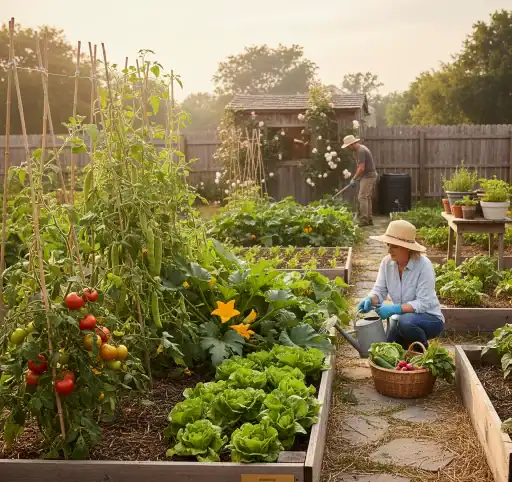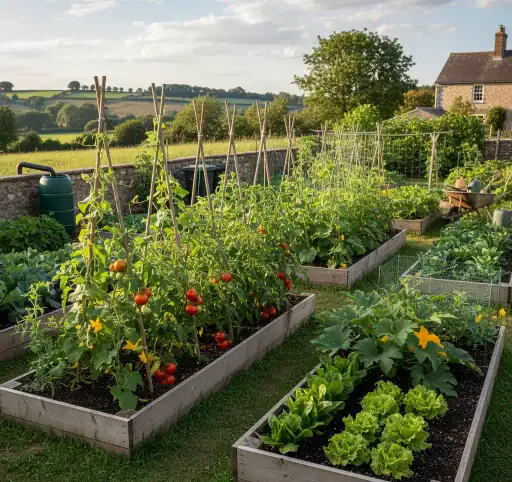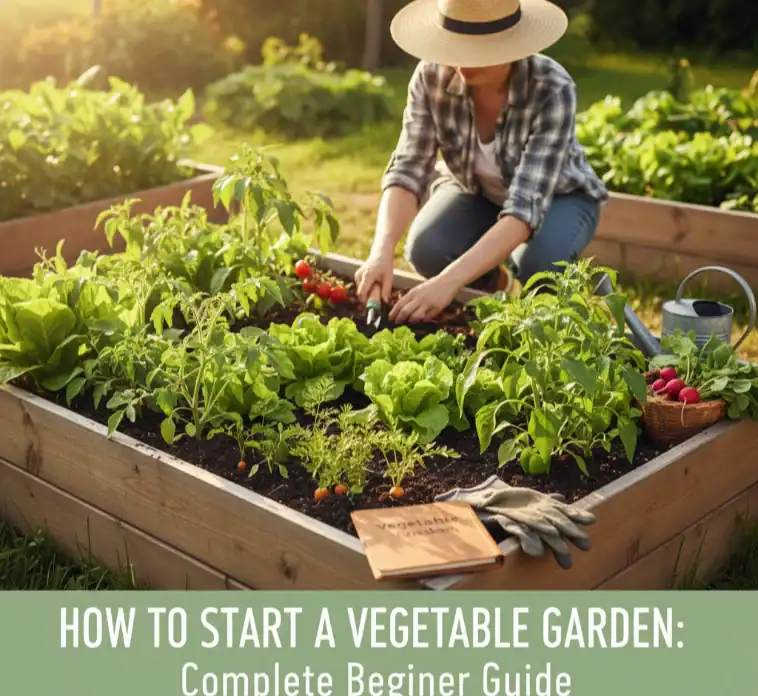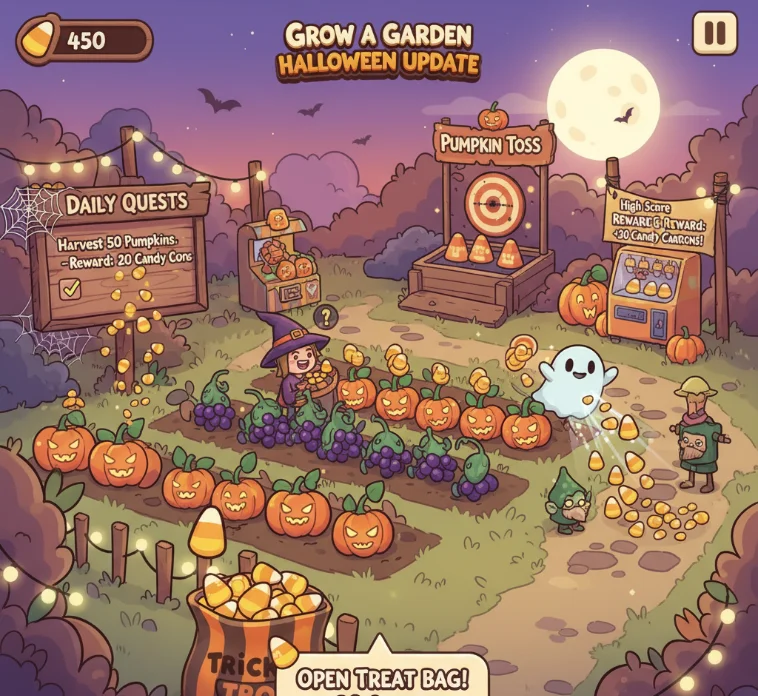Setting up a vegetable garden gives your backyard a productive, healthy plot for your family to enjoy fresh-to-table meals. Whether you are starting your first garden or have been growing a garden for years, this guide will help you grow high-yield crops year after year.
Why Start a Vegetable Garden?
Sure, there’s a cost savings at the grocery store, but there really is more to love about growing your own vegetables! A garden-variety vegetable bounty is more delicious than what you get in the store and so simple to achieve. You control what goes into your soil and onto your plants, making food that is chemical-free for you to eat.
And best of all, a well-planned vegetable garden can also be an excellent form of exercise and stress reduction. A few people find therapy in the act of working the dirt and caring for plants.
How to Plant a Vegetable Garden: A Step-by-Step Guide and Tips for Gardening
Pick a Suitable Location
Just where the vegetable garden is makes a difference, too. The majority of vegetables require at least six to eight hours of direct sun a day. Watch how the sun moves through your yard during the day to see which areas get full sunlight.
Good drainage is as important. No vegetables are going to grow in soil that is waterlogged. If the place that you have chosen becomes a pool after it has rained, you probably need to make raised beds or improve the drainage of the soil. Water gardening is so much easier when water is on hand! Position your garden close to a hose or irrigation system.
Test and Prepare Your Soil
Healthy soil creates healthy plants. You can find out by testing your soil pH with a digital meter or DIY kit available at any garden center. The average vegetable plant likes slightly acidic to neutral soil with a pH of 6.0 to 7.0.
Incorporate organic matter such as compost or aged manure to help with soil structure and fertility. If you intend to plant, the changes made to the soil to a depth of 8-12 inches should be your first step. Clean the area that you are going to plant of weeds, stones, or debris. A garden fork or a tiller can be used to loosen the compacted soil.
Plan Your Garden Layout
They should start small if they’re new to gardening. You can easily plant three varieties of vegetables without getting buried in chores in a 4×4-foot garden bed.
Just use a pencil and paper to sketch your design. Whatever plants you choose, it is very important for you to consider their final size and give them enough space! You want tall crops, such as tomatoes, to be to the north so that they don’t shade shorter ones. Place similar water and care needs cluster plants together. This results in the maintenance becoming easier and efficient.
Best Vegetables for Beginner Gardens
Easy-to-Grow Options
Some vegetables are particularly forgiving for the beginning gardener. The lettuce, radishes, and spinach come up quickly and grow easily. These plants can also take a little colder weather, keeping your growing period going strong. Bush beans are good producers in a small space and need no support. They enhance soil by taking nitrogen from the air.
Tomatoes are a bit higher maintenance, but they give you the most bang for your buck. Shop for determinate varieties when you are new to it because they do not need much pruning and staking.
Climate Considerations
Select vegetables that are well-suited for your local climate and growing season. Many regions have spring days and fall ones, ideal for cool-season crops like broccoli, peas, and carrots.
Warm-Season Vegetables: This includes peppers, squash, and cucumbers, which require consistently warm temperatures, so wait until after the last frost date to plant. Contact your local Agricultural Extension office or experienced gardeners in your region for timing guidelines.
How to Plant a Garden: The A-Z Guide
Timing Your Plantings
The timing of this work will help develop vegetables to their highest potential and produce the most in harvest. These are crops that prefer cool weather and can be started 2-4 weeks before the spring frost.
Don’t plant warm-season vegetables until soil temperatures have crossed the 60-degree mark. Cold soil is growth-inhibiting and can kill tender plants. Schedule succession plantings of crops such as lettuce and radishes. Succession plant in 2-3 week intervals for continuous harvesting, all season long.
Planting Techniques
Plant the seed at the depth and spacing indicated on the seed packet. As a general guideline, seeds should be sown at two times their width in depth. New seeds should be watered lightly to prevent them from being washed out. Water needs to be given to the seeds that are germinating. If you want to keep track of your planting history, jot down what you have planted and when. This is useful for maintenance scheduling and in planning a harvest.
Transplanting Seedlings
There are a number of varieties, and many gardeners start with transplants for crops like tomatoes and peppers. Set out plants at the same depth they were growing in their containers. Water the transplants well after planting and shade for a few days if there is hot weather forecasted. Harden off homegrown seedlings by progressively increasing their exposure to outside conditions over 7-10 days before planting.
Growing Garden Vegetables: Care and Maintenance

Watering Strategies
Regular watering encourages the vegetables to grow evenly, and at the same time, it helps in avoiding the occurrence of some common problems. Most vegetables need about one inch of water per week, which can be either irrigation or rainfall. The key is to water deeply and not so often to develop the roots deeply. Shallow, frequent watering results in a weak root system, which suffers during droughts. Water the soil instead of the leaves, as it is practical. This actually lessens issues of disease and gets water to the roots quickly.
Fertilizing Your Vegetable Garden
Heavy-Feeding Vegetables: Most of the vegetables require a lot of nutrients to grow to their full potential. When you plant, use a balanced fertilizer and follow the label instructions.
Side-dress heavy feeders—the ones that require a larger amount of nutrients per day to grow—like corn and tomatoes, with extra fertilizer every 4 – 6 weeks during the growing season. Organic offerings, such as compost, fish emulsion, and bone meal, supply slow-release nutrition that improves the health of soil, in strict contrast to easily washed away synthetic fertilizers.
Pest and Disease Management
A daily walk through your garden is an excellent chance to spot a problem at its early stage, if it happens. Insects, diseases, and nutrient deficiencies in plants should be your weekly check. Let the good insects come in by planting some flowers around your vegetable garden. Marigolds, nasturtiums, and zinnias are the flowers that attract beneficial predators, which provide you with a natural solution for controlling the pest population.
You can also practice crop rotation, which is an organic method of farming that means planting a different family of plants in each garden segment every year. This is breaking the pest and disease cycles, which accumulate in soil over time.
Best Advanced Methods for Growing a Garden
Companion Planting
Strategic blends of plants can facilitate growth and limit pest problems. Basil: Planting basil near tomatoes is said to enhance their flavor and also drive away pests.
The Three Sisters planting is a tradition in which corn, beans, and squash are planted together in Native American culture. Corn offers structure for beans, which in turn provide nitrogen for corn and squash. For those interested in different approaches to grow a garden, understanding these traditional methods can be valuable.
Avoid bad bedfellows by not planting tomatoes near black walnut trees, which release chemicals that are toxic to tomatoes and other vegetables.
Season Extension Methods
Extend the growing season with row covers and cold frames. Row covers and cold frames are also tools that can be used to extend your growing season, because they offer protection from light frosts. These humble affairs may extend your harvest by weeks.
This way of doing things consists of sowing a new crop as soon as your first one is finished, and it can help ensure even harvests through the growing season with quick-growing crops, like lettuce or radishes, and green beans. Sow cool-season crops for a fall harvest in late summer. And most winter vegetables can taste sweeter—if they’re grown in adverse conditions.
Maximizing Small Space
Vertical growing makes small gardens more productive with food. Trellis or fence-trained vining crops like cucumbers and pole beans. Square foot gardening involves using a raised bed and dividing that bed into one-foot squares, using less than 33% of the space with conventional growing. With container gardening, you could actually produce vegetables on patios, balconies, and other small spaces. Pick small types that are container-friendly.
How to Succeed With Your Vegetable Garden
Record Keeping
Keep a garden notebook logging when you plant, which varieties, and how much harvest results. It is knowledge we are using to better plan and select varieties in the future. Write down the weather as well, and what it does to your vegetables. This information is useful for determining when to plant other seeds and tracking garden issues.
Take pictures throughout the growing season to record your successes and struggles. Some trends are not visible only from written notes, but also from visual records.
Continuous Learning
Join a gardening club in your neighborhood or a group of similar climatic areas and learn from the gardeners. Knowledge of the region is also good for knowing the growing conditions and the specifics of the area.
Use the workshops and the demonstrations at the extension, the garden center, and the club to your advantage. Skill-building is faster with hands-on learning. Try out new varieties and approaches each season. Little trials are learning, without risking your whole crop.
Mistakes to Avoid in the Vegetable Garden

Overplanting
New gardeners tend to plant more than they can reasonably maintain or harvest. Begin small and grow slowly as your ability and time allow. Factor in the actual amount of vegetables that your family will eat when you’re planning. Six zucchini plants will overwhelm most families with squash.
Inadequate Spacing
Overcrowded plants have to fight for nutrients, water, and light, which leads to stunted growth and more disease problems. Observe the space requirements and err on the side of caution, even if you think it’s overkill. Good spacing promotes air circulation, which decreases problems related to fungal diseases that do well in moist, stagnant environments.
Neglecting Soil Health
Great soil is the key to a thriving vegetable garden. This is an easy fix with applications of organic matter and getting the pH within the proper range for growing. If the ground is still moist, you should avoid walking through the vegetable patch, as this will compact the soil structure and limit the roots and water that can penetrate.
Harvesting and Storing Your Vegetables
Optimal Harvest Timing
Many vegetables, such as tomatoes, have an ideal ripeness at harvest. Assess the maturity of each crop that you plant. Pick leafy greens in the cool of the morning when they are fully hydrated and crisp. There is nothing to prevent the root vegetables from being lifted during the day. Harvesting regularly promotes more and continual production in such crops as beans, squash, and peppers. Inspect plants every couple of days at peak season.
Proper Storage Methods
Various vegetables require different storage conditions to preserve them and to extend their useful life. Note that each of your crops must have its own method. Different vegetables have different reactions to being separated from the plant. For example, tomatoes are still ripening after they have been picked, while lettuces are losing their freshness rapidly and need to be consumed as soon as possible. The following is some advice on how to store your garden’s produce, which will allow you to have the harvest that you have planted during the winter.
Frequently Asked Questions
What is the minimum space required for starting a vegetable garden?
When to Plant Vegetables?
What are the easiest vegetables to grow for a beginner?
How much sun does a vegetable garden need?
Can I grow vegetables in containers?
How to stop bugs from eating my vegetables?
What are the biggest mistakes new gardeners make?
Conclusion
It takes planning, patience, and learning how to start the best vegetable garden ever. Start with something easily grown and in a small, manageable area. Consider soil health, spacing, and regular care. And please remember that every gardener has their ups and downs. Look at them as lessons, not failures. From there, the more you garden, the better you will become at it—and your harvests will thank you for it. And the joy of eating fresh vegetables you grew yourself makes it all worth the work. Planting Season gets you started on your growing season—and reaping the rewards of spring gardening!

























